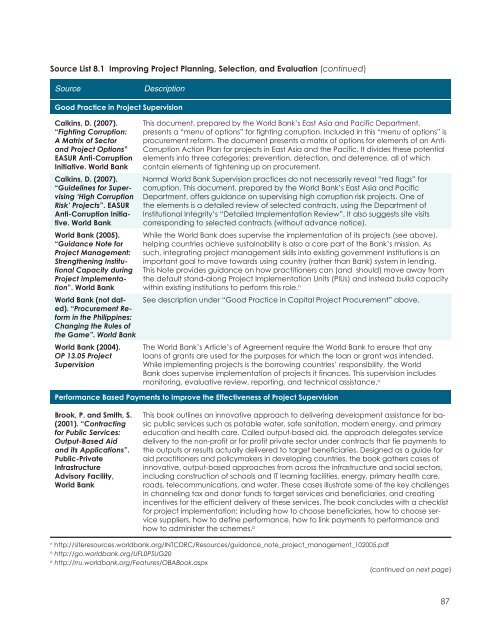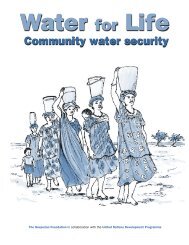A Sourcebook - UN-Water
A Sourcebook - UN-Water
A Sourcebook - UN-Water
Create successful ePaper yourself
Turn your PDF publications into a flip-book with our unique Google optimized e-Paper software.
Source List 8.1 Improving Project Planning, Selection, and Evaluation (continued)<br />
Source<br />
Description<br />
Good Practice in Project Supervision<br />
Calkins, D. (2007).<br />
“Fighting Corruption:<br />
A Matrix of Sector<br />
and Project Options”<br />
EASUR Anti-Corruption<br />
Initiative. World Bank<br />
Calkins, D. (2007).<br />
“Guidelines for Supervising<br />
‘High Corruption<br />
Risk’ Projects”. EASUR<br />
Anti-Corruption Initiative.<br />
World Bank<br />
World Bank (2005).<br />
“Guidance Note for<br />
Project Management:<br />
Strengthening Institutional<br />
Capacity during<br />
Project Implementation”.<br />
World Bank<br />
World Bank (not dated).<br />
“Procurement Reform<br />
in the Philippines:<br />
Changing the Rules of<br />
the Game”. World Bank<br />
World Bank (2004).<br />
OP 13.05 Project<br />
Supervision<br />
This document, prepared by the World Bank’s East Asia and Pacific Department,<br />
presents a “menu of options” for fighting corruption. Included in this “menu of options” is<br />
procurement reform. The document presents a matrix of options for elements of an Anti-<br />
Corruption Action Plan for projects in East Asia and the Pacific. It divides these potential<br />
elements into three categories: prevention, detection, and deterrence, all of which<br />
contain elements of tightening up on procurement.<br />
Normal World Bank Supervision practices do not necessarily reveal “red flags” for<br />
corruption. This document, prepared by the World Bank’s East Asia and Pacific<br />
Department, offers guidance on supervising high corruption risk projects. One of<br />
the elements is a detailed review of selected contracts, using the Department of<br />
Institutional Integrity’s “Detailed Implementation Review”. It also suggests site visits<br />
corresponding to selected contracts (without advance notice).<br />
While the World Bank does supervise the implementation of its projects (see above),<br />
helping countries achieve sustainability is also a core part of the Bank’s mission. As<br />
such, integrating project management skills into existing government institutions is an<br />
important goal to move towards using country (rather than Bank) system in lending.<br />
This Note provides guidance on how practitioners can (and should) move away from<br />
the default stand-along Project Implementation Units (PIUs) and instead build capacity<br />
within existing institutions to perform this role. n<br />
See description under “Good Practice in Capital Project Procurement” above.<br />
The World Bank’s Article’s of Agreement require the World Bank to ensure that any<br />
loans of grants are used for the purposes for which the loan or grant was intended.<br />
While implementing projects is the borrowing countries’ responsibility, the World<br />
Bank does supervise implementation of projects it finances. This supervision includes<br />
monitoring, evaluative review, reporting, and technical assistance. o<br />
Performance Based Payments to Improve the Effectiveness of Project Supervision<br />
Brook, P. and Smith, S.<br />
(2001). “Contracting<br />
for Public Services:<br />
Output-Based Aid<br />
and its Applications”.<br />
Public-Private<br />
Infrastructure<br />
Advisory Facility,<br />
World Bank<br />
This book outlines an innovative approach to delivering development assistance for basic<br />
public services such as potable water, safe sanitation, modern energy, and primary<br />
education and health care. Called output-based aid, the approach delegates service<br />
delivery to the non-profit or for profit private sector under contracts that tie payments to<br />
the outputs or results actually delivered to target beneficiaries. Designed as a guide for<br />
aid practitioners and policymakers in developing countries, the book gathers cases of<br />
innovative, output-based approaches from across the infrastructure and social sectors,<br />
including construction of schools and IT learning facilities, energy, primary health care,<br />
roads, telecommunications, and water. These cases illustrate some of the key challenges<br />
in channeling tax and donor funds to target services and beneficiaries, and creating<br />
incentives for the efficient delivery of these services. The book concludes with a checklist<br />
for project implementation: including how to choose beneficiaries, how to choose service<br />
suppliers, how to define performance, how to link payments to performance and<br />
how to administer the schemes. p<br />
n<br />
http://siteresources.worldbank.org/INTCDRC/Resources/guidance_note_project_management_102005.pdf<br />
o<br />
http://go.worldbank.org/UFL0PSUG20<br />
p<br />
http://rru.worldbank.org/Features/OBABook.aspx<br />
(continued on next page)<br />
87
















